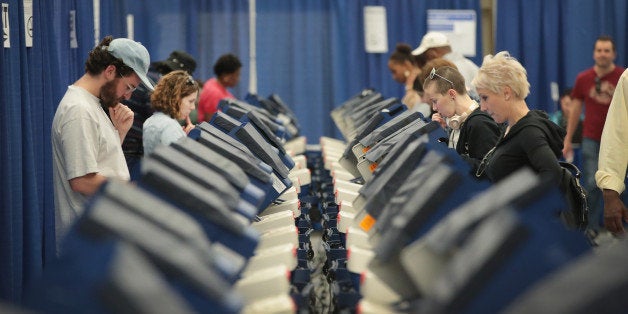
 Austin is a member of the Junior State of America (JSA), a student-run political awareness organization for high school students.
Austin is a member of the Junior State of America (JSA), a student-run political awareness organization for high school students.
Since 1964, when the District of Columbia was granted three electoral votes, there have been 538 total electoral votes in the electoral college. That means that there has been a chance for the last 48 years that the electoral vote could be an exact tie: 269-269.
The chance for a 269-269 tie has never been more real than it is in this electoral cycle. While the likelihood of there being a tie is not overwhelming, it is significantly higher than in any previous presidential election in the modern era.
For the purposes of this article, the swing states shall be defined as New Hampshire, Pennsylvania, Virginia, North Carolina, Florida, Ohio, Michigan, Iowa, Wisconsin, Colorado and Nevada. The number of solid electoral votes for Obama can then be assumed to be 201 and the number of solid Romney votes is 191. The most likely route to an Electoral College tie by far is in Romney winning Florida (29), North Carolina (15), Virginia (13), Colorado (9), Iowa (6) and Nevada (6), in addition to all of the states where he has a solid lead over Obama.
Think this is unlikely? Well, maybe not so, according to Nate Silver's fivethirtyeight election blog. The Fivethirtyeight electoral prediction model is widely regarded as the most objective and realistic election statistics available to the general public. In the Fivethirtyeight "now cast," Nate Silver predicts how the election would turn out if held today. In Iowa and Nevada, Romney is not far behind with a 44 percent and 39 percent chance of victory respectively. As you can see, there is a very realistic chance that Mitt Romney will be able to reach 269 electoral votes. After Nevada's 39 percent chance of victory, there is a sizable drop down in Romney's likelihood of victory in swing state with Ohio at 32 percent and then New Hampshire at 29 percent and Wisconsin at 19 percent. Although the chance of a 269-269 tie is not overwhelming, there is a very realistic chance that it could happen.
So we have established that there is a realistic chance that there will be an electoral college; the next logical question is what exactly happens if there is a 269-269 tie? Luckily, the United States Constitution provides for this possibility. The 12th Amendment to the Constitution states that in the event that no single candidate receives a majority of the electoral vote, the House of Representatives must decide from the candidates with the top three electoral vote counts.
Each state delegation, not each Representative, gets one vote in this process. That means that while California's 53 Representatives must decide amongst themselves who to cast their one vote for, Vermont congressman Peter Welch must only consult himself before getting the same amount of votes as California.
Three times in history, the house has decided who the president would be. In 1800, they decided the electoral college tie between Thomas Jefferson and Aaron Burr. In 1824, they decided the four-way race in which the candidate who won the plurality of electoral votes, Andrew Jackson, lost to John Quincy Adams. In 1876, they decided the infamous Hayes/Tilden election.
If no vice-presidential candidate receives the majority of electoral votes, then the senate decides from the top two finishers, with each senator getting one vote.
Because Republicans control the larger number of state delegations, chances are that in a 269-269 tie, the House would choose Gov. Romney to become President. However, because the senate is controlled by Democrats, in all likelihood they would vote for Joe Biden over Paul Ryan to become vice-president. This means that in the event of an Electoral College tie, we could actually be looking at a president and vice-president from different political parties for the first time since the passing of the 12th Amendment in 1804.
It is possible that congress could do the ethical thing, and in the event of an Electoral College tie, give the winner of the popular vote the presidency and vice-presidency. But in our current political climate, I do not see that as a strong possibility.
There is also a possibility that if Gov. Romney was selected to be president, Joe Biden would concede the vice-presidency to Paul Ryan, but this becomes further complicated if there is a 50-50 tie in the Senate and the vice-president must be the tie breaking vote which is even more likely to occur than the 269-269 tie.
Imagine what the political climate of our country would be if a 269-269 tie occurs -- especially if the House chooses the candidate who lost the popular vote to become president. Maybe then there would finally be the political clout necessary to finally eliminate the archaic and undemocratic system that is the Electoral College.